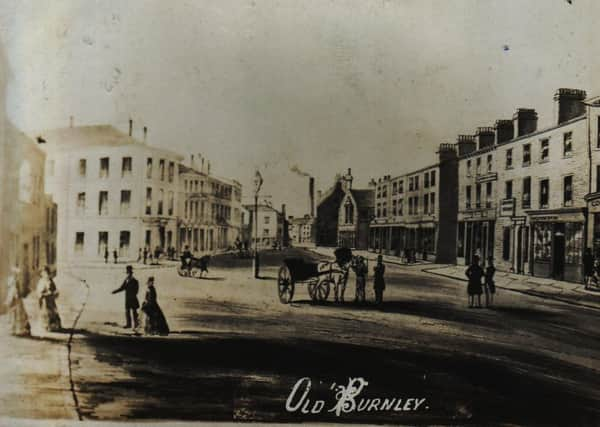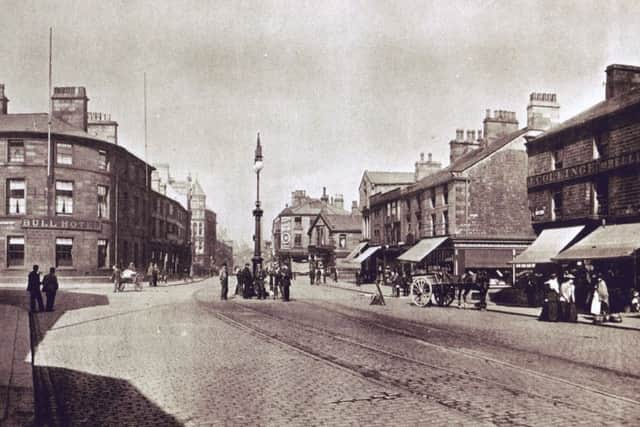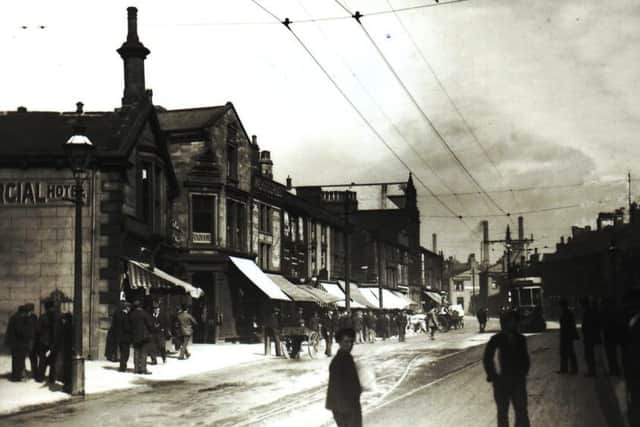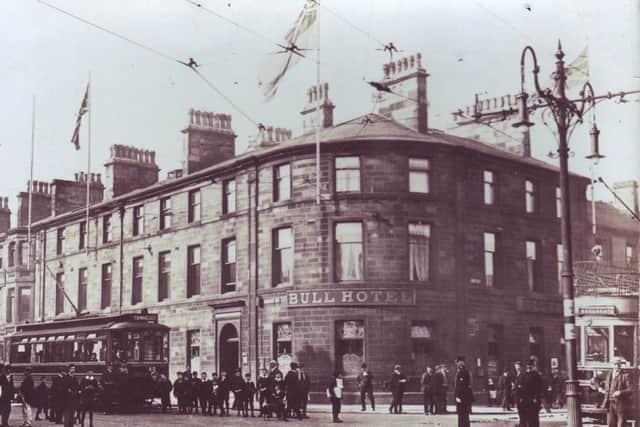‘Improvements’ could mean loss of Burnley history


I would concede I have written about the lamps before but a number of images of the “gaumless” (the one at the bottom of Manchester Road) have recently come into the possession of the Briercliffe Society, so I thought I would share them. The borough and county councils are proposing to invest £3m. on “improvements to (Burnley’s) pedestrianised area”, but these proposals involve the removal of the present “gaumless”, the bandstand and charity arch.
I am not going to defend all three. The latter has not been the success it was hoped it would be when it was installed and a better place for the bandstand would be Ightenhill Park where there are lots of well-supported public events. A bandstand there would add to the offer, as they say, and I understand the Friends of Ightenhill Park would love to have the facility installed, at little or no cost to Burnley Council, at the site of their former bandstand.
Advertisement
Hide AdAdvertisement
Hide AdHowever, I am going to defend the “gaumless”, but, first, I should make it clear what it is. This is a monumental street lamp situated at the junction of St James’s Street and Manchester Road. The one there now is not the original. It was placed there by Burnley Council when St James’s Street was pedestrianised between 1993 and 1994, but, if you look at the first of today’s images, which dates from the early 1850s, you will see the present structure is similar to the one in the picture.


The first “gaumless” was put in place by Burnley Gas Company in 1823. The company was founded that year with a gas works near the canal, access to which was from Parker Lane. Many of you will remember the old Gas Offices in Parker Lane. They were there because that is where Burnley’s gas industry was established, 200 years ago.
The purpose of the “gaumless” lamp was not only to throw light at a busy junction but to demonstrate the effectiveness of gas lighting. Gas was produced from coal, at Parker Lane Gas Works, and distributed through the town in specially-laid underground pipes. People, however, were used to candle light and oil lamps and there was some resistance to gas lighting because of the cost of maintaining the mantles.
There were, though, great advantages to the use of gas. Industrialists were among the first to recognise the importance of gas as it allowed them to introduce shift work so they could keep their factories open longer. Shopkeepers liked gas as they could improve their window displays and householders also saw the advantages of gas because, relative to its predecessors, it was relatively clean.
Advertisement
Hide AdAdvertisement
Hide AdThe site chosen for the first “gaumless” was, at the time, the most important road junction in Burnley. In fact, it was more a crossroads rather than a junction, as Bridge Street continued, almost opposite, on the other side of St James’s Street, in the direction of the Brun and King’s Mill.


The lamp stood in the middle of the road and the first of the pictures shows this very well. The fact the lamp was always in the middle of the road resulted in the name by which it was known to Burnley people, “the gaumless”. This was because, the “gaumless” stood in the middle of the road where accidents were more likely!
Burnley’s “gaumless” was a famous piece of what we would now call “street furniture”. Everybody knew the feature as “the gaumless” and would chuckle with pride when they told visitors the reason why it was so called. There were “gaumlesses” at almost all Burnley’s main road junctions, perhaps the best known of which were the ones at the bottom of Westgate, at Gannow Top and the junction of Briercliffe Road and Thursby Road. There was a very impressive one in Padiham where Burnley Road and Victoria Road came together.
However, the one at the bottom of Manchester Road was the original and most admired. It was like a familiar friend met on regular visits to the market hall or St James’s Street. Though the town centre “gaumless” was replaced by larger and better models, over the years, proposals to make alterations were not met with much public support whenever they were suggested. In the end, changes were made as the illustrations which accompany this article testify.
Advertisement
Hide AdAdvertisement
Hide AdThe first picture shows the “gaumless” as it was in about 1852 though the postcard which carries the image was used in 1905. As you can see, it was quite small but occupied the site of the present replica at the bottom of Manchester Road. Notice the two-wheeled carriage in front of the lamp. It was here Burnley’s first “hackney carriage rank” was located. I do not need to remind you the same space was occupied by Burnley’s “open market” from the late 18th Century when the market moved from Church Street outside St Peter’s Church.


The building to the left of the lamp is the Bull Hotel and you can see that better in the second picture which was taken 50 years after the first image was drawn. In 1904 a tram line was constructed on Manchester Road so this photo was taken before then. In the picture the “gaumless” has changed. It is much taller and it appears there are two lights on the lamp rather than one. The lamp looks to have been a popular spot for local people to meet and chat.
The third image is taken from lower down St James’s Street and, for this we have to thank Mr Edward Walton who has made this image available to us. The “gaumless” is to the right near the double-decker tram. You can see a large bracket has been fixed to the top of the central column, not to carry additional lights, but the electric cables supplying power to the trams. As the network was electrified in 1901, this image must have been taken at that time or a little after. I can’t see whether the 1904 line on Manchester Road had been constructed when the image was taken.
The photo is an exceptionally clear one of the shops near the Market Street junction with St James’s Street. The Commercial Hotel was the Thorn. Notice the young lads, centre and right, were very much aware a photographer was at work.
Advertisement
Hide AdAdvertisement
Hide AdThe fourth picture shows the “gaumless” in an even later incarnation. The scene is taken from a splendid postcard posted in 1908. As you can see the lamp on the right but you will have noticed the tram lines on Manchester Road have been constructed. This dates this image to 1904 or a little after.
What might not be apparent is that the “gaumless” must have learned a thing or two, because it is no longer in the middle of the road! It remained close to the Manchester Road-St James’s Street junction but had been moved to the pavement on the odd side of St James’s Street. This may have been done when the Manchester Road tramlines were laid. In fact, and I have not looked into this, but it could be this image was taken on the day when the Manchester Road tram line was opened or first put to use. The people present are all aware something important is happening.
This article is something of an appeal to the Ccuncil. It is hoped the replica “gaumless” be kept at its present location. It was, I think, placed there by Coun. Edward Ingham when he was Mayor, 20 years ago. It would be a pity to lose this reminder of Burnley’s past. And, while I am thinking about this, it appears no provision is being made for the preservation of the stone which marks the actual centre of town: the Mere Stone as it was known.
Vandals of an earlier generation had removed the Mere Stone and not replaced it but, a few years ago, Burnley Civic Trust placed a replica stone, quite close to the existing “gaumless”. The original stone had marked the centre of the former “Police Circle”. This had been determined by Act of Parliament in 1819 to establish the boundary in which Burnley’s Improvement Commissioners, fore-runners of the council, could operate. The stone was a feature of this area and it is marked on early maps of Burnley and even on early drawings of property in this part of town.
Advertisement
Hide AdAdvertisement
Hide AdSo, in one fell swoop, the borough and county councils are proposing to remove two reminders of Burnley’s past from the same town centre location. I realise a consultation is taking place but this aspect of it could have been resolved before the plans were made public.
This is worrying in itself but there are other matters which should be brought to your attention. Some local residents have talked about the £3m. cost of the pedestrianisation project but others point to previous projects carried out by LCC in Nelson and Preston. The one I know best is in Nelson and the word “nightmare” comes to mind when I think about it. The Preston example, which I believe is on Fishergate, has been voted, I am assured, the sixth worst pedestrianisation scheme ever!
I am all for improving Burnley’s facilities but not at the cost of what has happened on Manchester Road and Scotland Road, Nelson. Let’s hope that the consultation results in a little common sense!